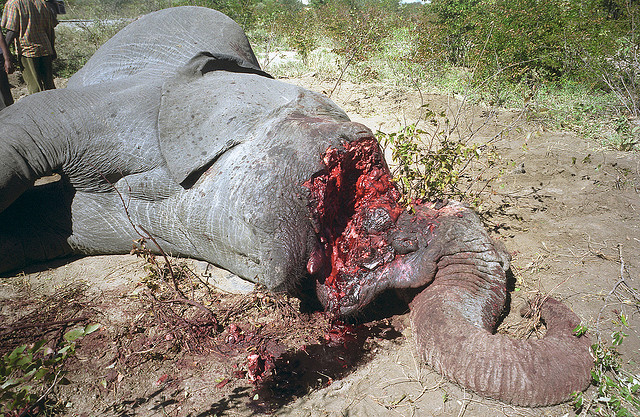“Poaching menace in Kenya – a crisis or challenge?”
April 21 The Kenyan wildlife service must acknowledged the magnitude of the country’s poaching problem, writes Brian Dan Migowe, 23, a Correspondent from Kenya, who says that community awareness and policing along with tough laws are needed to stop the slaughter.
The Kenyan wildlife service must acknowledged the magnitude of the country’s poaching problem, writes Brian Dan Migowe, 23, a Correspondent from Kenya, who says that community awareness and policing along with tough laws are needed to stop the slaughter.
Kenya insists the battle over poaching has not been lost and it is not overwhelmed with the fight against poaching, resisting calls from conservationists and wildlife activists to declare the on-going butcher of elephants and rhinos a national disaster.
The head of the Kenya wildlife service, the state run institution mandated with the protection and conservation of wildlife, dismissed allegations that known ring-leaders of the rhino horn and elephant ivory poaching groups were acting with impunity and in complete neglect of wildlife conservation. Six rhinos have been killed in the last one week in spite of the new anti-poaching law that stipulates hefty fines or life imprisonment for the offenders. One more rhino was wounded and is fighting for its life as I write this piece. This rising wave of killings has startled conservationists who fear that the new law may not deter the determined poachers. Meanwhile the state claims that it has not lost its fighting teeth, saying the fight against the poaching of elephant and rhino population “is not a crisis but a challenge” and thus cannot be declared a national disaster as conservationists want.
It is time the Kenya wildlife service acknowledged the magnitude of the problem that they are facing – certainly not a sole Kenyan fight but a regional one. As prices and demands increase, so do the illegal killing of rhinos and elephants in sub-Saharan Africa. This is the time to declare the high poaching rate in the game reserves and the national parks of the country a national disaster or else see its elephants and rhinos go extinct-something that would be a major blow to safari destination tourism earnings. It is that time to acknowledge that with rhinos being killed in the most heavily guarded zones – the Nairobi national park which happens to be the headquarters of the Kenya wildlife service – that these poachers have little fear of tough new laws. No amount of policing without community awareness, community cooperation and community policing, together with the Kenya wildlife service rangers, will stop the butcher of the Kenyan wild for horns and ivory.
I am a worried citizen; it worries me especially when statistical experts say if the poaching trends continue, Kenya will have no rhinos in three years. Poaching is responsible for 60 per cent of the rhino deaths in the country. The poaching menace has reached a record high in two decades, says Kenya wildlife service. The country plans to deploy surveillance drones to help fight the poaching activities, a good move worth the investment. Tsavo National Park in the south east is Kenya’s largest, with sweeping plains and occasional water holes dotted with wildlife, yet with the increase in poaching this beautiful park faces a threat of depletion of its beauty! The elephant trumpets, roars and rumbles. Because of growing demand and high prices offered for elephant ivory and rhino horns in Far East Asian countries, Kenya has lost 18 rhinos and 51 elephants to poachers this year alone. Last year 59 rhinos and 308 elephants were killed, compared to 30 rhinos and 384 elephants in 2012.
Without too much criticism on the Kenya wildlife service’s slow process of handling the poaching menace, I am not hesitant to give credit where it’s due. In January this year a Kenyan court convicted a Chinese man for smuggling ivory and ordered him to pay a fine of 233,000 dollars or spend seven years in jail. This was the first sentence to be handed out since the introduction of the new anti-poaching law, and I believe the courts are standing up to their enforcement mandate for punitive measures to be given to poachers.
My cries, like so many of my fellow citizens, have indeed been heard. As a law student, the judiciary is my hero for now. It is safeguarding our interest at large, moreover, Kenyan tourism’s boost to the East African economy. What lies ahead of the Kenya wildlife service is not to give a statistical outlook on the increasing numbers of illegal rhino and elephant killings, but to spring with full action to the best possible modes of reducing the deaths to insignificant numbers, and protect the Kenyan rhinos and elephants. This is indeed a challenge unmanaged at its crisis level.
photo credit: Greenwich Photography via photopin cc
………………………………………………………………………………………………………
About me: I am a law student with a passion for writing and youth advocacy. I observe people, nature, the environment and daily life and am enthusiastic about sharing them on pen and paper.
I am an open-minded individual who acknowledges the diversity of the world’s population. Sometimes I am awed by how life plays out, but in writing I make the story as I want it. My hobbies are swimming and indoor games.
…………………………………………………………………………………………………………………
Opinions expressed in this article are those of the author and do not necessarily represent the views of the Commonwealth Youth Programme. Articles are published in a spirit of dialogue, respect and understanding. If you disagree, why not submit a response?
To learn more about becoming a Commonwealth Correspondent please visit: http://www.yourcommonwealth.org/submit-articles/commonwealthcorrespondents/
…………………………………………………………………………………………………………………




